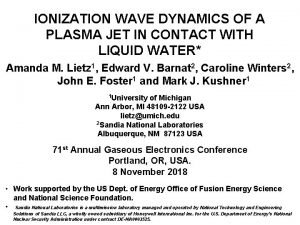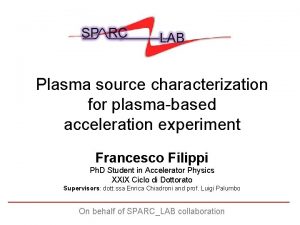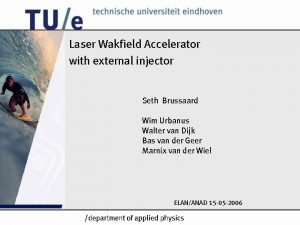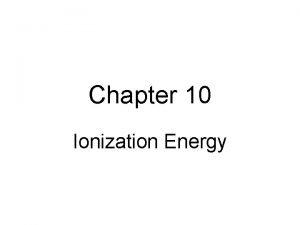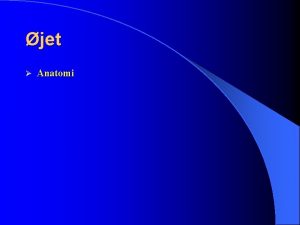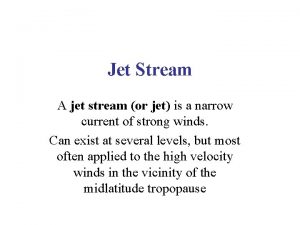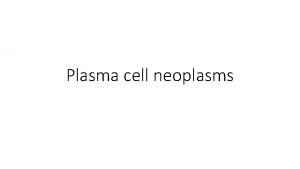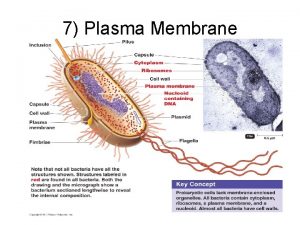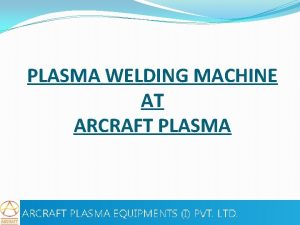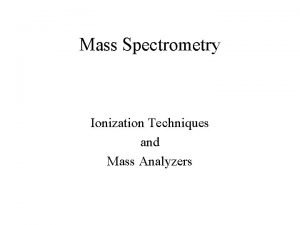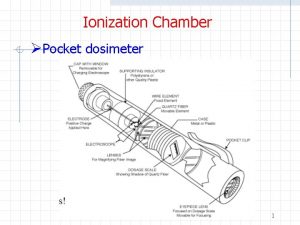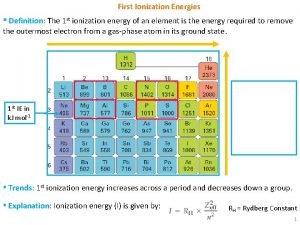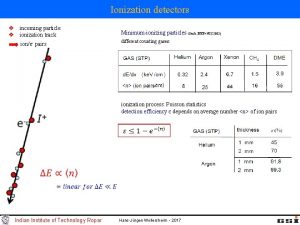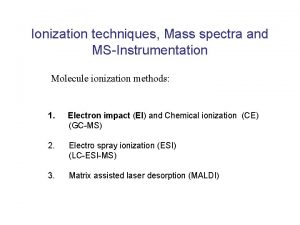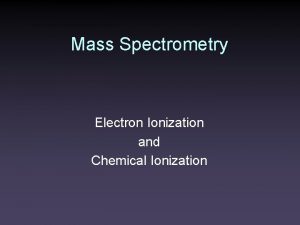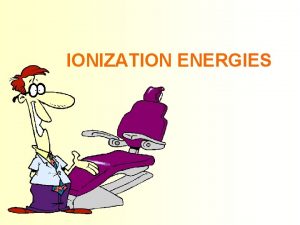IONIZATION WAVE DYNAMICS OF A PLASMA JET IN















- Slides: 15

IONIZATION WAVE DYNAMICS OF A PLASMA JET IN CONTACT WITH LIQUID WATER* Amanda M. Lietz 1, Edward V. Barnat 2, Caroline Winters 2, John E. Foster 1 and Mark J. Kushner 1 1 University of Michigan Ann Arbor, MI 48109 -2122 USA lietz@umich. edu 2 Sandia National Laboratories Albuquerque, NM 87123 USA 71 st Annual Gaseous Electronics Conference Portland, OR, USA. 8 November 2018 • Work supported by the US Dept. of Energy Office of Fusion Energy Science and National Science Foundation. • Sandia National Laboratories is a multimission laboratory managed and operated by National Technology and Engineering Solutions of Sandia LLC, a wholly owned subsidiary of Honeywell International Inc. for the U. S. Department of Energy’s National Nuclear Security Administration under contract DE-NA 0003525.

AGENDA Plasma Jets onto Liquids Description of Experiment Laser Collisional Induced Fluorescence (LCIF) Plasma Jet Contacting Ti. O 2 (�� r = 80) Plasma Jet Contacting Liquid Water Modeling and Future Work GEC_2018 University of Michigan Institute for Plasma Science & Engr.

ATMOSPHERIC PRESSURE PLASMA JETS Atmospheric pressure plasma jets (APPJs) are a popular source of chemistry for biomedical applications. The plasma propagates as an ionization wave (IW) that is repetitively pulsed. The IW gives rise to reactive oxygen and nitrogen species (RONS) which produce the biological effect. Objective: Investigation IW dynamics in a plasma jet contacting liquid in a well controlled environment. GEC_2018 • S. Mohades, et al. , Physics of Plasmas 22, 122001 (2015). University of Michigan Institute for Plasma Science & Engr.

EXPERIMENTAL SETUP Ti. O 2/H 2 O Annular powered electrode inside the center tube. Placing the APPJ in a vacuum chamber - consistent and controlled chemistry, ground planes, and gas flow. Coaxial tube enables a gas shroud – control environment independently of gas in main jet. GEC_2018 University of Michigan Institute for Plasma Science & Engr.

LASER COLLISIONAL INDUCED FLUORESCENCE (LCIF) An ultrashort pulse laser (<100 fs) was used to measure the electron density with high time resolution. Electrons collide with laser excited He(33 P) e + He(33 P) He(33 D) + e Barnat and Fierro, J. Phys. D: Appl. Phys. , 50, 14 LT 01 (2017). GEC_2018 ne is proportional to ratio of LIF signals (588 nm / 389 nm) Sufficient He(23 S) density is critical for accurate LCIF data. LCIF was initially developed for pure He, and extended to mixtures for this study of APPJs. University of Michigan Institute for Plasma Science & Engr.

BASE CASE +6 k. V 380 ns pulse, 100 ns rise 200 Torr Faster dynamics (for modeling) Lower background LCIF signal (for experiment) 500 sccm He in center tube 0. 75% H 2 O in He in shroud, 500 sccm Gap to target: 7. 5 mm Substrate: Liquid water or Ti. O 2 2. 5 mm thick (same / 0) Current measured at ground electrode under water/Ti. O 2. GEC_2018 Shroud Tube Central Tube Imaging Region Ti. O 2/Liquid University of Michigan Institute for Plasma Science & Engr.

HUMID He SHROUD 2. 3% H 2 O in shroud Pure He MFC #1 MFC #2 To center of jet To shroud MFC #3 Humid He shroud confines the jet, much like operating with surrounding air, while being compatible with LCIF measurements. First bubbler oversaturates water vapor, second bubbler removes excess. Temperature of second bubbler determines humidity of gas. Animation Slide GEC_2018 University of Michigan Institute for Plasma Science & Engr.

LCIF IN HUMID He 6 k. V, 430 ns pulse Center: 500 sccm He Shroud: 500 sccm He/H 2 O = 97. 7/2. 3 t = 230 ns, 30 ns after IW contacts surface Moving away from He core, there are fewer He(23 S), LIF signal decreases. He(23 S) + H 2 O He + H 2 O+ + e In regions of high H 2 O concentration, there may be significant ne which is not detectable due to low He(23 S). Ratio = 1 ne ≈ 4 1012 cm-3 GEC_2018 University of Michigan Institute for Plasma Science & Engr.

H�� He(33 P) Ti. O 2: OPTICAL EMISSION GEC_2018 Ti. O 2 substrate 5 ns ICCD gate, He(33 P) →He(23 S): 389 nm, H emission: 656 nm Line of sight imaging (not Abel inverted). Even He(33 P) emission, indicating an annular electron density. Surface ionization wave (SIW) forms after IW contacts the surface. University of Michigan Institute for Plasma Science & Engr.

Ti. O 2: ELECTRON DENSITY Electron density profile is annular. Photons from the discharge (He* or He 2*) ionize H 2 O. Photoionization selectively occurs in the mixing region of the pure He with the humid He. After IW contacts the surface and a restrike occurs, the electron density nearly doubles. Ratio = 1 ne ≈ 4 1012 cm-3 GEC_2018 University of Michigan Institute for Plasma Science & Engr.

H�� He(33 P) WATER: OPTICAL EMISSION Water substrate. 5 ns ICCD gate Evaporation results in much higher concentrations of H 2 O enabling more photoionization and Penning ionization. IW contacts surface 5 ns earlier than for Ti. O 2 substrate. Plasma dims at 230 ns, after contacting the surface. GEC_2018 University of Michigan Institute for Plasma Science & Engr.

WATER: ELECTRON DENSITY Water substrate. Electron density (ne) is again annular due to photoionization and Penning ionization of surrounding water vapor. SIW is not visible by LCIF because high H 2 O density near the surface depletes He(23 S) + H 2 O He + H 2 O+ + e Electron density is slightly higher than for Ti. O 2 because of higher water vapor density. GEC_2018 Ratio = 1 ne ≈ 4 1012 cm-3 University of Michigan Institute for Plasma Science & Engr.

WATER vs. Ti. O 2 With water base, magnitude of forward current is higher, reverse current is lower. Forward current enhanced by humidity. Electrons/ions solvate into the water while being physisorbed on Ti. O 2. Water less likely to support electron emission to support reverse of current. Evaporation produces higher water concentrations near surface resulting in lower mobility, thinner SIW. Plasma dims after IW contacts liquid surface. Animation Slide GEC_2018 University of Michigan Institute for Plasma Science & Engr.

MODELING LIQUID INTERACTIONS Cylindrically symmetric. Modeling work ongoing. Same parameters as experiment. non. PDPSIM – 2 -dimensional plasma hydrodynamics model Photoionization and photoemission from surfaces are critical in positive IW propagation. Surface ionization wave develops along the liquid surface. Electron density profile is annular. GEC_2018 University of Michigan Institute for Plasma Science & Engr.

CONCLUDING REMARKS An ionization wave exiting a He plasma jet into a humid environment is annular due to Penning ionization and photoionization at the boundary. Plasma in contact with water vs Ti. O 2 (same / 0) are distinguishable from electrical I-V traces. Mild humidity above the water produces larger forward current. Solvation of electrons/ions in water and larger humidity above water result in lower reverse current. SIWs propagating over a liquid surface are thinner due to the lower mobility of electrons in a saturated water vapor environment. GEC_2018 University of Michigan Institute for Plasma Science & Engr.
 Yelvington jet aviation aircraft fuel
Yelvington jet aviation aircraft fuel Plasma jet
Plasma jet Plasma wave
Plasma wave Enrica chiadroni
Enrica chiadroni Reda akdim
Reda akdim Half wave rectifier definition
Half wave rectifier definition Wave wave repeating
Wave wave repeating What is a semiconductor used for
What is a semiconductor used for Velocity frequency wavelength triangle
Velocity frequency wavelength triangle Bridge full wave rectifier
Bridge full wave rectifier What is quarter wave symmetry
What is quarter wave symmetry The wave chapter 10
The wave chapter 10 Difference between full wave and half wave rectifier
Difference between full wave and half wave rectifier P and s wave chart
P and s wave chart Mechanical waves vs electromagnetic waves venn diagram
Mechanical waves vs electromagnetic waves venn diagram Compare and contrast transverse and longitudinal waves
Compare and contrast transverse and longitudinal waves

